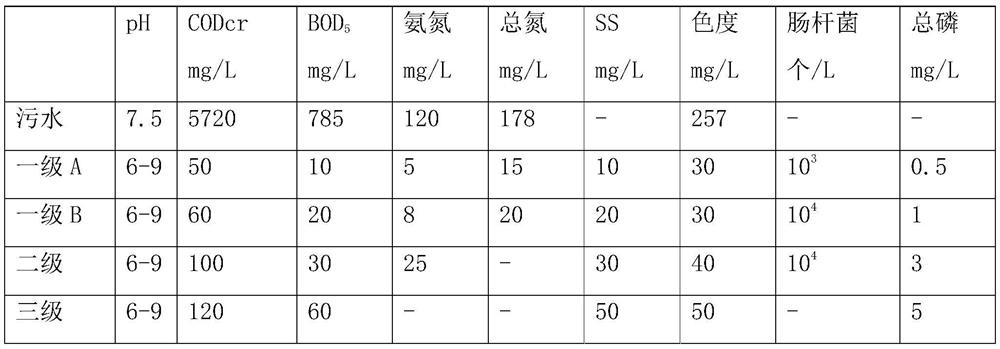Treatment process for treating organic sewage by using ionizing radiation in cooperation with catalyst
An ionizing radiation, organic sewage technology, applied in special compound water treatment, filtration treatment, water/sewage treatment and other directions, can solve the problems of secondary pollution, complicated operation, difficult treatment, etc., to reduce treatment costs, simple operation, Response to the effect of low environmental requirements
- Summary
- Abstract
- Description
- Claims
- Application Information
AI Technical Summary
Problems solved by technology
Method used
Image
Examples
Embodiment 1
[0050] The landfill leachate sewage to be treated (indicators shown in Table 1) passes through the following units in sequence:
[0051] (1) Coarse filtration unit: add polymer to the sewage, perform aeration treatment, and enter the mud-water separation device to remove solids;
[0052] (2) Biochemical unit: an aerobic biochemical reactor, which is provided with an enzyme floating filler, and the residence time is 2h;
[0053] (3) Ionizing irradiation unit: Sewage is injected through the nozzle to form a 2mm thick water film for electron beam irradiation (energy is 2.5MeV, beam intensity is 50mA), and then contacted with multi-layer metal mesh loaded with catalyst, metal Catalysts are loaded on the net. The catalyst is four kinds of metal oxides of magnesium, aluminum, copper and manganese supported on the activated carbon substrate.
[0054] (4) Biochemical unit: facultative / aerobic biochemical reactor, which is equipped with enzyme floating packing, and the residence time...
Embodiment 2
[0072] For printing and dyeing sewage to be treated, the indicators are CODcr=2154.3mg / L, ammonia nitrogen=55.6mg / L, total nitrogen=65.1mg / L, BOD 5 =673.0mg / L, pH=7.72.
[0073] Go through the following units in order:
[0074] (1) Coarse filtration unit: perform magnetic separation to remove solids in sewage;
[0075] (2) Biochemical unit: an aerobic biochemical reactor, which is provided with an enzyme floating filler, and the residence time is 2.5h;
[0076] (3) Ionizing irradiation unit: The sewage flows in a flow channel, first irradiated with a cobalt source, and the absorbed dose is 1kGy, and then enters the flow channel with a catalyst at the bottom after 5s, and leaves the ionizing irradiation unit after 30s ; The catalyst is three metal oxides of Mg, Ni and Mn loaded on the porous substrate of aluminum oxide.
[0077] (4) Biochemical unit: facultative / aerobic biochemical reactor, which is equipped with enzyme floating packing, and the residence time is 8h;
[007...
PUM
 Login to View More
Login to View More Abstract
Description
Claims
Application Information
 Login to View More
Login to View More - Generate Ideas
- Intellectual Property
- Life Sciences
- Materials
- Tech Scout
- Unparalleled Data Quality
- Higher Quality Content
- 60% Fewer Hallucinations
Browse by: Latest US Patents, China's latest patents, Technical Efficacy Thesaurus, Application Domain, Technology Topic, Popular Technical Reports.
© 2025 PatSnap. All rights reserved.Legal|Privacy policy|Modern Slavery Act Transparency Statement|Sitemap|About US| Contact US: help@patsnap.com



